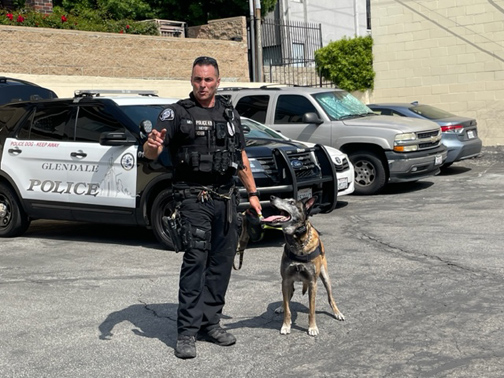
Photo by Mary O’KEEFE
The Alan Schultz State Farm Insurance Agency, located in the 1900 block of West Glenoaks Blvd., played host to some special guests last week – the Glendale Police Dept. K-9 Unit.
Schultz is a supporter of the K-9 Unit and donates to help keep the Unit active. All training, food and equipment for the dogs is provided by donations from the community through the Glendale Police Foundation, a non-profit organization that supports the department. It costs about $20,000 to $30,000 per dog for the initial purchasing and training of a dog.
Sgt. Shawn Sholtis, K-9 supervisor, and Agt. Eric Meyer, K-9 Officer Jeff, Agt. Paul Shubunka and K-9 Officer Dante came to the parking lot at Alan Schultz State Farm for a demonstration on how the dogs work with their handlers.
“The dog needs to understand how to range [meaning] he has to work in front of his handler,” Sholtis explained.
Meyer explained how the dogs and police officers work together when conducting investigations. Some dogs are trained to find firearms, others are trained for drug detection and some dogs are trained for area and building searches.
Meyer shared a story of a friend who was an officer with another agency and how he was looking for a suspect he believed was in an area where there were parked vehicles. It was not known if the suspect was in a vehicle or outside the vehicles. While his friend searched, a suspect who was in a vehicle with dark tinted windows attacked the officer.
This is an incident when the K-9s would be valuable because they can search quickly, detect and alert the officer.
The K-9s are an important part of police work for GPD. An example was given of when officers knew a suspect was hiding under a porch, which was very dark. The officers were not certain if the suspect was armed. If the officer crawled under the porch, using his/her flashlight, s/he could become a target.
Instead the officer was able to stay outside the porch and call to the suspect. He told him to come out and that they had a dog that could be sent in. The suspect then came out.
Sholtis said that technique was used many times when a warning is first given of a dog being present.
“If we respond to an alarm call and we see a window smashed we can respond and use K-9s to search,” Sholtis said.
The K-9s and the agents have a very close relationship that begins with the initial six-week training session. After six months to a year the dog goes in for secondary training; this is usually detection of drugs, guns or explosives. However, the dogs are training as well on a daily basis with their handlers.
“You may see us at the park throwing a ball [to the dog]. Most people think we are out [just having fun], but we are not,” Meyer said. “We are training.”
It is important for the dogs to listen to their handlers for many reasons including for the dogs’ own safety.
“Let’s say a suspect runs across Glenoaks Boulevard. Our dog is not going to look out for cars, he isn’t going to do anything except try to get that suspect, so a handler has to be able to stop that dog,” Meyer explained.
That is why the handlers spend so much time with their dogs. They’re constantly training to make certain the dogs listen to their commands. But it was also evident, as Jeff jumped to greet Meyer, that there is a bond between the dog and handler that comes from long hours and service together.
The K-9 Unit is supported by the community. Anyone who would like to support the K-9 Unit can visit https://tinyurl.com/2s48sswt.
